Climatological Investigation of Ionospheric Es Layer Based on Occultation Data
Abstract
1. Introduction
2. Data and Methods
3. Results
4. Discussion
5. Conclusions
Author Contributions
Funding
Data Availability Statement
Acknowledgments
Conflicts of Interest
References
- Mathews, J. Sporadic E: Current views and recent progress. J. Atmos. Sol.-Terr. Phys. 1998, 60, 413–435. [Google Scholar] [CrossRef]
- Resende, L.C.; Arras, C.; Batista, I.S.; Denardini, C.M.; Bertollotto, T.O.; Moro, J. Study of sporadic E layers based on GPS radio occultation measurements and digisonde data over the Brazilian region. In Annales Geophysicae; Copernicus Publications: Göttingen, Germany, 2018; pp. 587–593. [Google Scholar] [CrossRef]
- Leighton, H.; Shapley, A.; Smith, E. The occurrence of sporadic E during the IGY. In Ionospheric Sporadic; Elsevier: Amsterdam, The Netherlands, 1962; pp. 166–177. [Google Scholar] [CrossRef]
- Perkins, F.; Doles, J., III. Velocity shear and the E × B instability. J. Geophys. Res. 1975, 80, 211–214. [Google Scholar] [CrossRef]
- Farley, D. Theory of equatorial electrojet plasma waves-new developments and current status. J. Atmos. Terr. Phys. 1985, 47, 729–744. [Google Scholar] [CrossRef]
- Hocke, K.; Tsuda, T. Gravity waves and ionospheric irregularities over tropical convection zones observed by GPS/MET radio occultation. Geophys. Res. Lett. 2001, 28, 2815–2818. [Google Scholar] [CrossRef]
- Wu, D.L.; Ao, C.O.; Hajj, G.A.; de La Torre Juarez, M.; Mannucci, A.J. Sporadic E morphology from GPS-CHAMP radio occultation. J. Geophys. Res. Space Phys. 2005, 110, A01306. [Google Scholar] [CrossRef]
- Arras, C.; Wickert, J.; Beyerle, G.; Heise, S.; Schmidt, T.; Jacobi, C. A global climatology of ionospheric irregularities derived from GPS radio occultation. Geophys. Res. Lett. 2008, 35, L14809. [Google Scholar] [CrossRef]
- Chu, Y.-H.; Wang, C.; Wu, K.; Chen, K.; Tzeng, K.; Su, C.-L.; Feng, W.; Plane, J. Morphology of sporadic E layer retrieved from COSMIC GPS radio occultation measurements: Wind shear theory examination. J. Geophys. Res. Space Phys. 2014, 119, 2117–2136. [Google Scholar] [CrossRef]
- Yue, X.; Schreiner, W.S.; Pedatella, N.M.; Kuo, Y.H. Characterizing GPS radio occultation loss of lock due to ionospheric weather. Space Weather 2016, 14, 285–299. [Google Scholar] [CrossRef]
- Zhou, C.; Tang, Q.; Song, X.; Qing, H.; Liu, Y.; Wang, X.; Gu, X.; Ni, B.; Zhao, Z. A statistical analysis of sporadic E layer occurrence in the midlatitude China region. J. Geophys. Res. Space Phys. 2017, 122, 3617–3631. [Google Scholar] [CrossRef]
- Luo, J.; Liu, H.; Xu, X. Sporadic E morphology based on COSMIC radio occultation data and its relationship with wind shear theory. Earth Planets Space 2021, 73, 212. [Google Scholar] [CrossRef]
- Xu, X.; Luo, J.; Wang, H.; Liu, H.; Hu, T. Morphology of sporadic E layers derived from Fengyun-3C GPS radio occultation measurements. Earth Planets Space 2022, 74, 55. [Google Scholar] [CrossRef]
- Seif, A.; Liu, J.Y.; Mannucci, A.J.; Carter, B.A.; Norman, R.; Caton, R.G.; Tsunoda, R.T. A study of daytime L-band scintillation in association with sporadic E along the magnetic dip equator. Radio Sci. 2017, 52, 1570–1577. [Google Scholar] [CrossRef]
- Schunk, R.W.; Nagy, A.F. Ionospheres: Physics, Plasma Physics, and Chemistry; Cambridge University Press: Cambridge, UK, 2000. [Google Scholar] [CrossRef]
- Kelley, M.C. The Earth’s Ionosphere: Plasma Physics and Electrodynamics; Academic Press: Cambridge, MA, USA, 2009. [Google Scholar]
- Yuan, T.; Wang, J.; Cai, X.; Sojka, J.; Rice, D.; Oberheide, J.; Criddle, N. Investigation of the seasonal and local time variations of the high-altitude sporadic Na layer (Nas) formation and the associated midlatitude descending E layer (Es) in lower E region. J. Geophys. Res. Space Phys. 2014, 119, 5985–5999. [Google Scholar] [CrossRef]
- Cai, X.; Yuan, T.; Eccles, J.V. A numerical investigation on tidal and gravity wave contributions to the summer time Na variations in the midlatitude E region. J. Geophys. Res. Space Phys. 2017, 122, 10577–10595. [Google Scholar] [CrossRef]
- Whitehead, J. The formation of the sporadic-E layer in the temperate zones. J. Atmos. Terr. Phys. 1961, 20, 49–58. [Google Scholar] [CrossRef]
- Whitehead, J. Production and prediction of sporadic E. Rev. Geophys. 1970, 8, 65–144. [Google Scholar] [CrossRef]
- Whitehead, J. Recent work on mid-latitude and equatorial sporadic-E. J. Atmos. Terr. Phys. 1989, 51, 401–424. [Google Scholar] [CrossRef]
- Macleod, M.A. Sporadic E theory. I. Collision-geomagnetic equilibrium. J. Atmos. Sci. 1966, 23, 96–109. [Google Scholar] [CrossRef]
- Nygren, T.; Jalonen, L.; Oksman, J.; Turunen, T. The role of electric field and neutral wind direction in the formation of sporadic E-layers. J. Atmosheric Terr. Phys. 1984, 46, 373–381. [Google Scholar] [CrossRef]
- Haldoupis, C.; Pancheva, D. Planetary waves and midlatitude sporadic E layers: Strong experimental evidence for a close relationship. J. Geophys. Res. Space Phys. 2002, 107, SIA 3-1–SIA 3-6. [Google Scholar] [CrossRef]
- Yamazaki, Y.; Arras, C.; Andoh, S.; Miyoshi, Y.; Shinagawa, H.; Harding, B.; Englert, C.; Immel, T.; Sobhkhiz-Miandehi, S.; Stolle, C. Examining the wind shear theory of sporadic E with ICON/MIGHTI winds and COSMIC-2 radio occultation data. Geophys. Res. Lett. 2022, 49, e2021GL096202. [Google Scholar] [CrossRef]
- Shinagawa, H.; Miyoshi, Y.; Jin, H.; Fujiwara, H. Global distribution of neutral wind shear associated with sporadic E layers derived from GAIA. J. Geophys. Res. Space Phys. 2017, 122, 4450–4465. [Google Scholar] [CrossRef]
- Qiu, L.; Yu, T.; Yan, X.; Sun, Y.Y.; Zuo, X.; Yang, N.; Wang, J.; Qi, Y. Altitudinal and latitudinal variations in ionospheric sporadic-E layer obtained from FORMOSAT-3/COSMIC radio occultation. J. Geophys. Res. Space Phys. 2021, 126, e2021JA029454. [Google Scholar] [CrossRef]
- Liu, Y.; Zhou, C.; Tang, Q.; Li, Z.; Song, Y.; Qing, H.; Ni, B.; Zhao, Z. The seasonal distribution of sporadic E layers observed from radio occultation measurements and its relation with wind shear measured by TIMED/TIDI. Adv. Space Res. 2018, 62, 426–439. [Google Scholar] [CrossRef]
- Yeh, W.H.; Liu, J.Y.; Huang, C.Y.; Chen, S.P. Explanation of the sporadic-E layer formation by comparing FORMOSAT-3/COSMIC data with meteor and wind shear information. J. Geophys. Res. Atmos. 2014, 119, 4568–4579. [Google Scholar] [CrossRef]
- Tang, L.; Li, J.; Zhang, F.; Zou, F. Comparative study of ionospheric sporadic E occurrence rates using SNRnstd and S4 derived from GPS radio occultation. GPS Solut. 2023, 27, 120. [Google Scholar] [CrossRef]
- Yu, B.; Xue, X.; Scott, C.J.; Yue, X.; Dou, X. An empirical model of the ionospheric sporadic E layer based on GNSS radio occultation data. Space Weather 2022, 20, e2022SW003113. [Google Scholar] [CrossRef]
- Schreiner, W.; Rocken, C.; Sokolovskiy, S.; Syndergaard, S.; Hunt, D. Estimates of the precision of GPS radio occultations from the COSMIC/FORMOSAT-3 mission. Geophys. Res. Lett. 2007, 34, L04808. [Google Scholar] [CrossRef]
- Anthes, R.; Schreiner, W. Six new satellites watch the atmosphere over Earth’s equator. EOS 2019, 100, 1–7. [Google Scholar] [CrossRef]
- Anthes, R.A.; Bernhardt, P.; Chen, Y.; Cucurull, L.; Dymond, K.; Ector, D.; Healy, S.; Ho, S.-P.; Hunt, D.; Kuo, Y.-H. The COSMIC/FORMOSAT-3 mission: Early results. Bull. Am. Meteorol. Soc. 2008, 89, 313–334. [Google Scholar] [CrossRef]
- Yeh, W.H.; Huang, C.Y.; Hsiao, T.Y.; Chiu, T.C.; Lin, C.H.; Liou, Y.A. Amplitude morphology of GPS radio occultation data for sporadic-E layers. J. Geophys. Res. Space Phys. 2012, 117, A11304. [Google Scholar] [CrossRef]
- Haldoupis, C. Midlatitude sporadic E. A typical paradigm of atmosphere-ionosphere coupling. Space Sci. Rev. 2012, 168, 441–461. [Google Scholar] [CrossRef]
- Yu, B.; Xue, X.; Yue, X.A.; Yang, C.; Yu, C.; Dou, X.; Ning, B.; Hu, L. The global climatology of the intensity of the ionospheric sporadic E layer. Atmos. Chem. Phys. 2019, 19, 4139–4151. [Google Scholar] [CrossRef]
- Kirkwood, S.; Nilsson, H. High-latitude sporadic-E and other thin layers–the role of magnetospheric electric fields. Space Sci. Rev. 2000, 91, 579–613. [Google Scholar] [CrossRef]
- MacDougall, J.; Plane, J.; Jayachandran, P. Polar cap sporadic-E: Part 2, modeling. J. Atmos. Sol. Terr. Phys. 2000, 62, 1169–1176. [Google Scholar] [CrossRef]
- Alken, P.; Thébault, E.; Beggan, C.D.; Amit, H.; Aubert, J.; Baerenzung, J.; Bondar, T.; Brown, W.; Califf, S.; Chambodut, A. International geomagnetic reference field: The thirteenth generation. Earth Planets Space 2021, 73, 49. [Google Scholar] [CrossRef]
- Wu, J.; Xiong, C.; Huang, Y.; Zhou, Y. Vertical gradients of neutral winds observed by ICON and estimated by the Horizontal Wind Model during the geomagnetic storm on August 26−28, 2021. Earth Planet. Phys. 2024, 9, 69–80. [Google Scholar] [CrossRef]

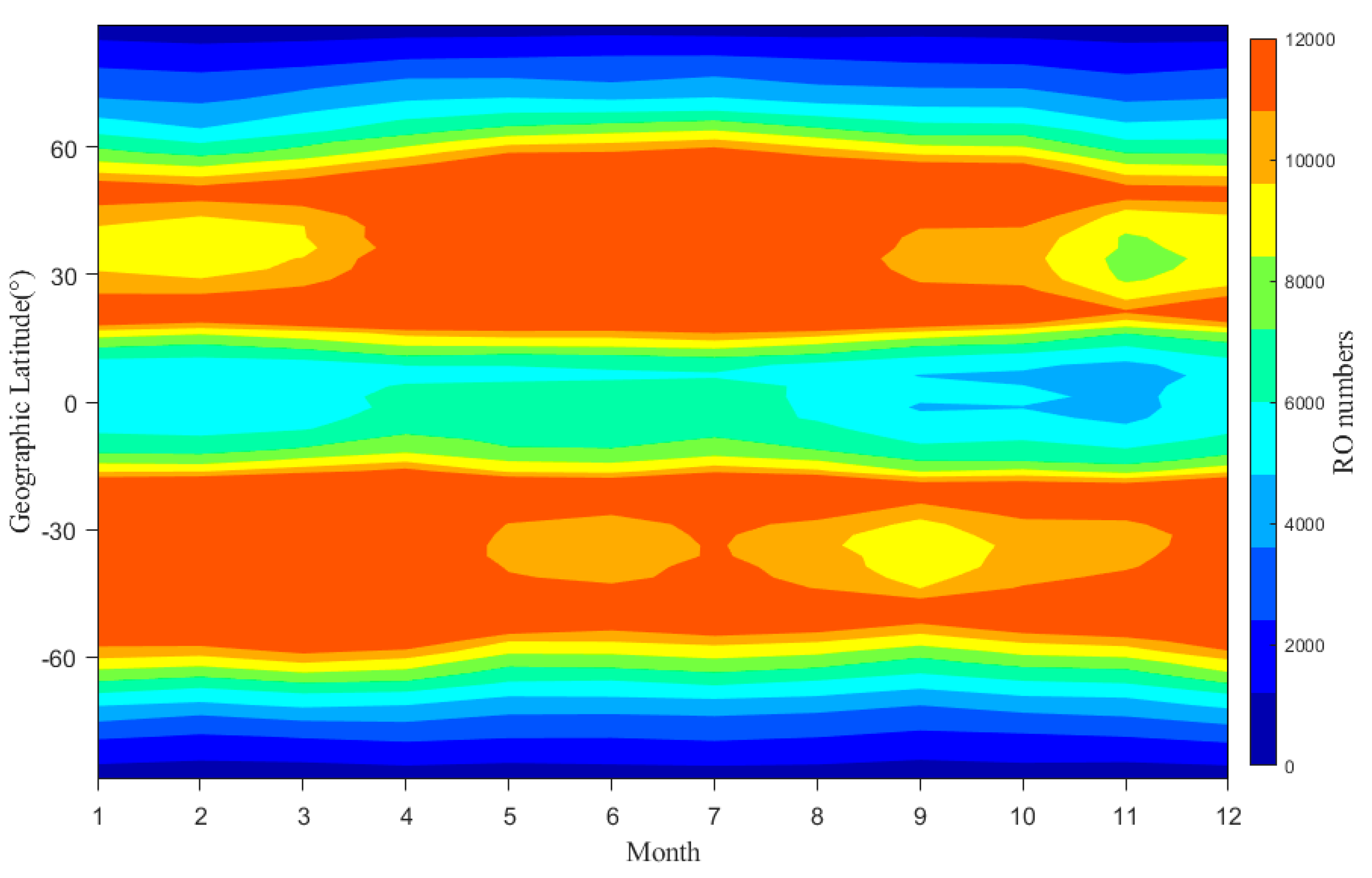
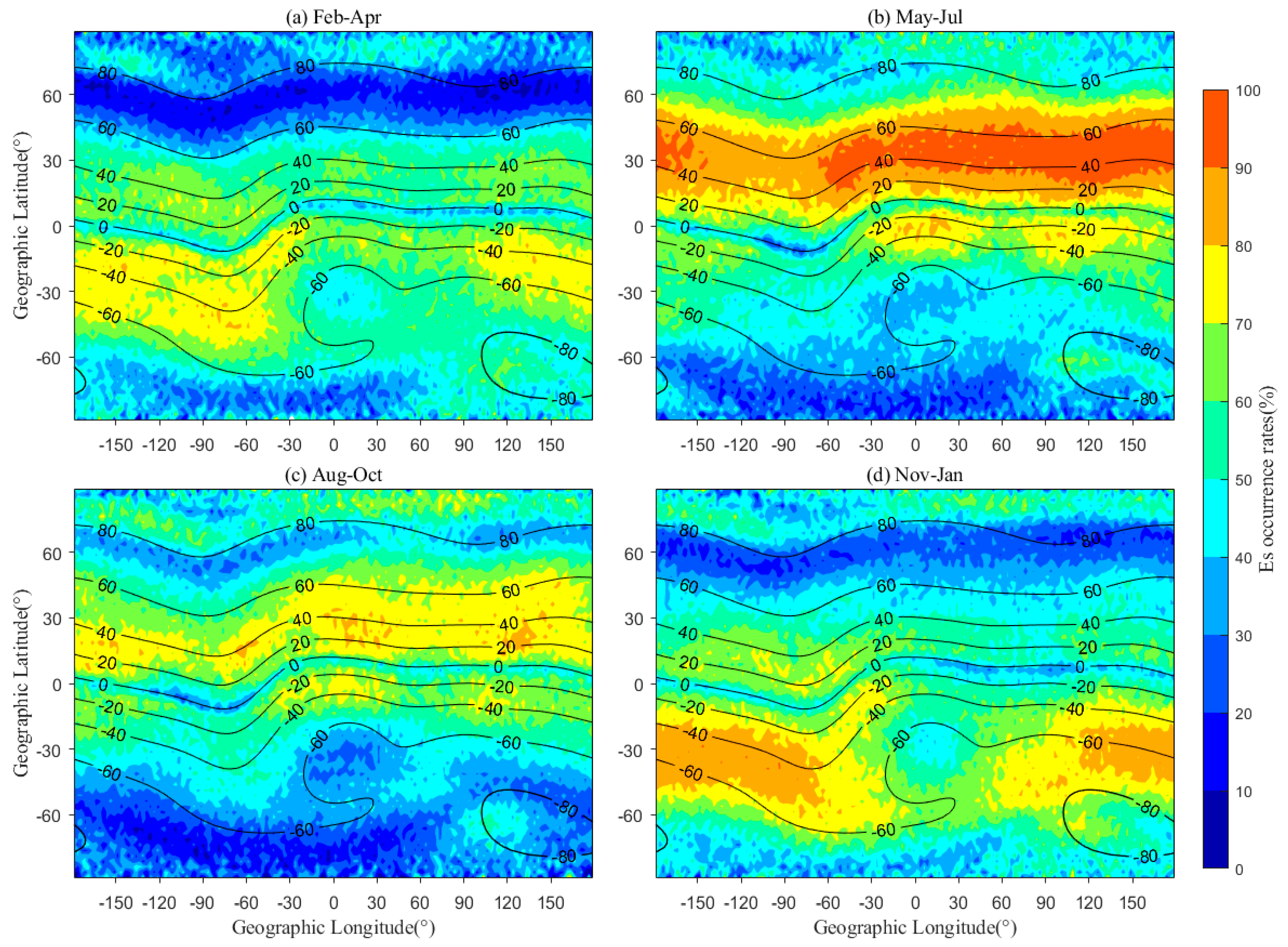
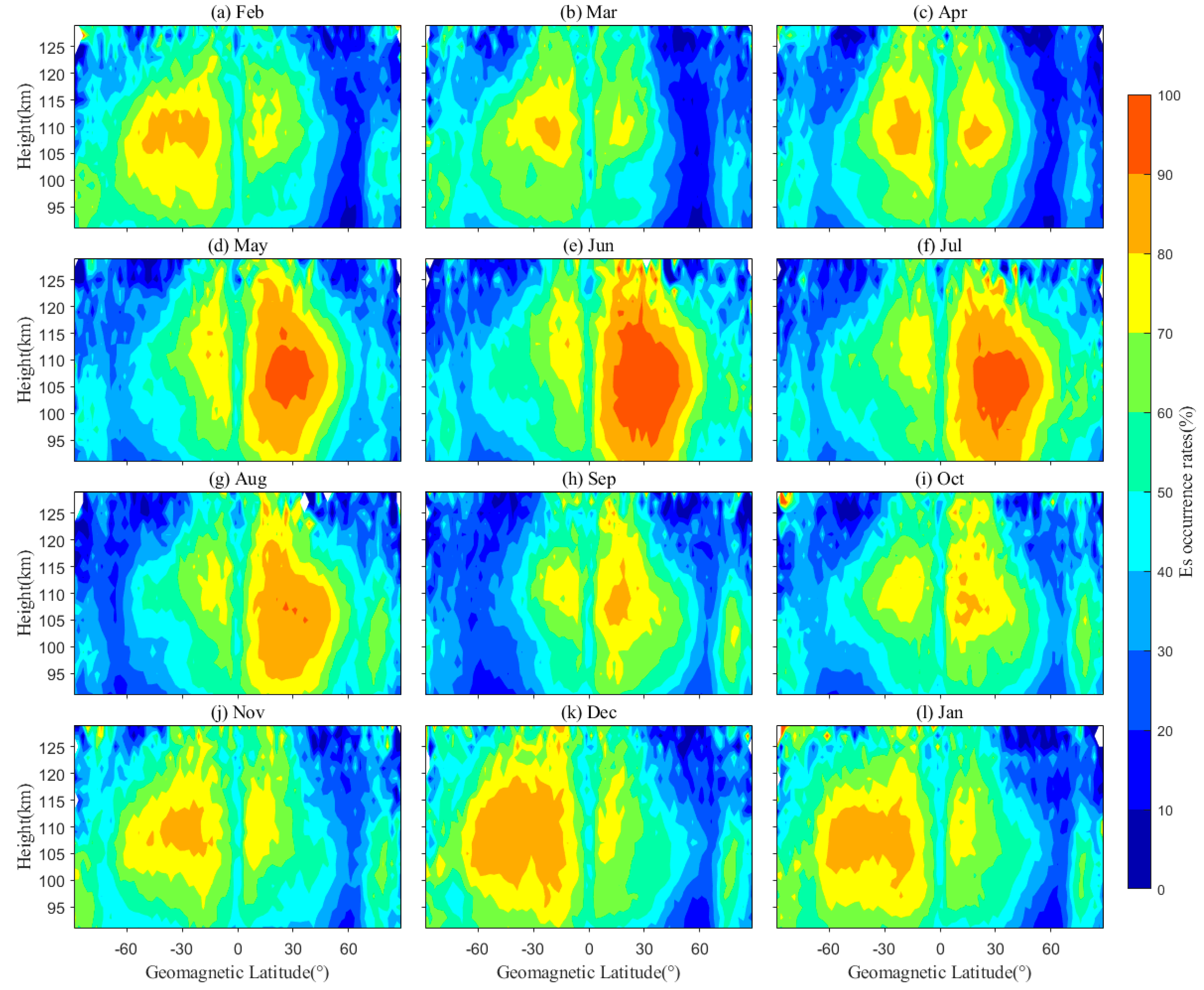
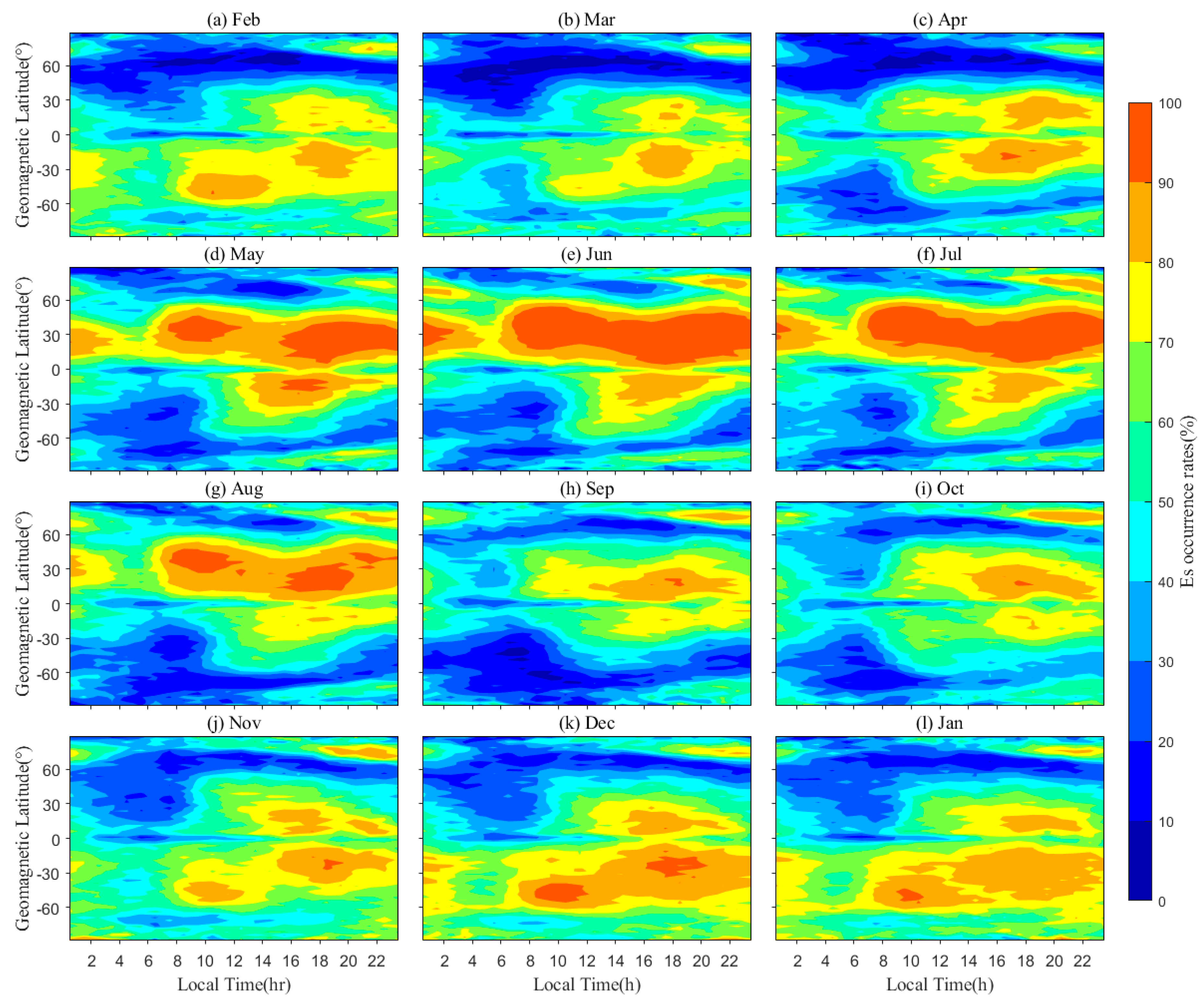

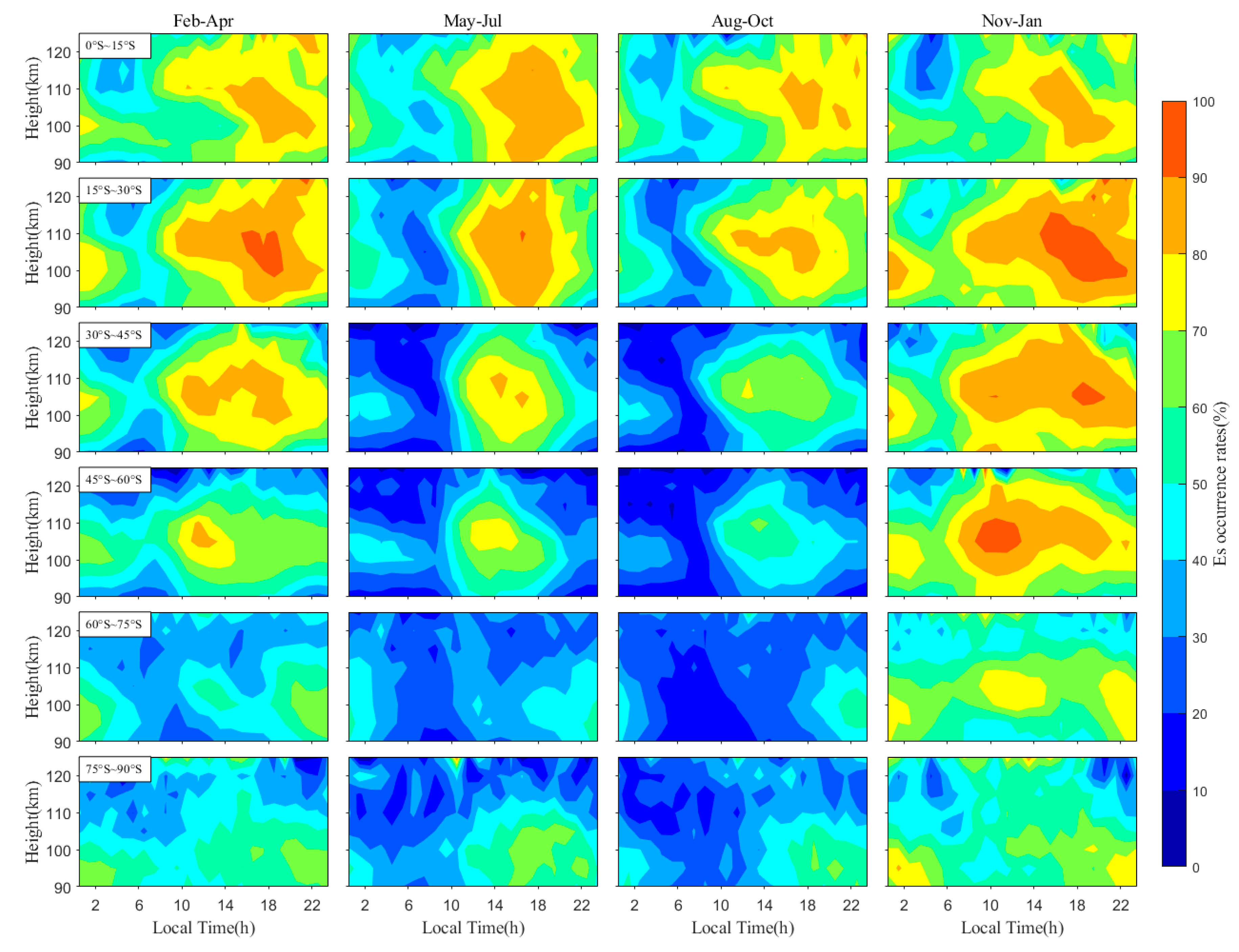
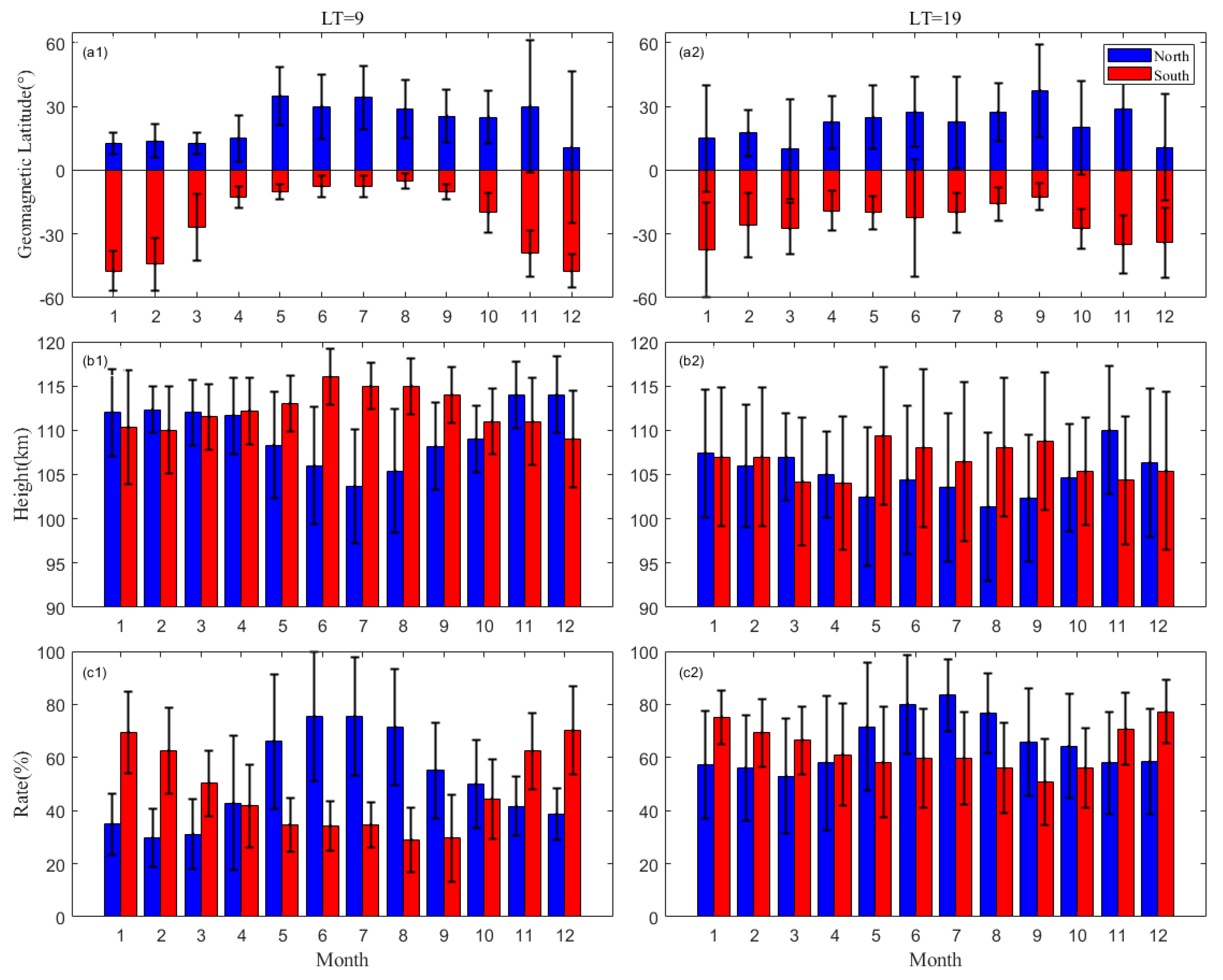
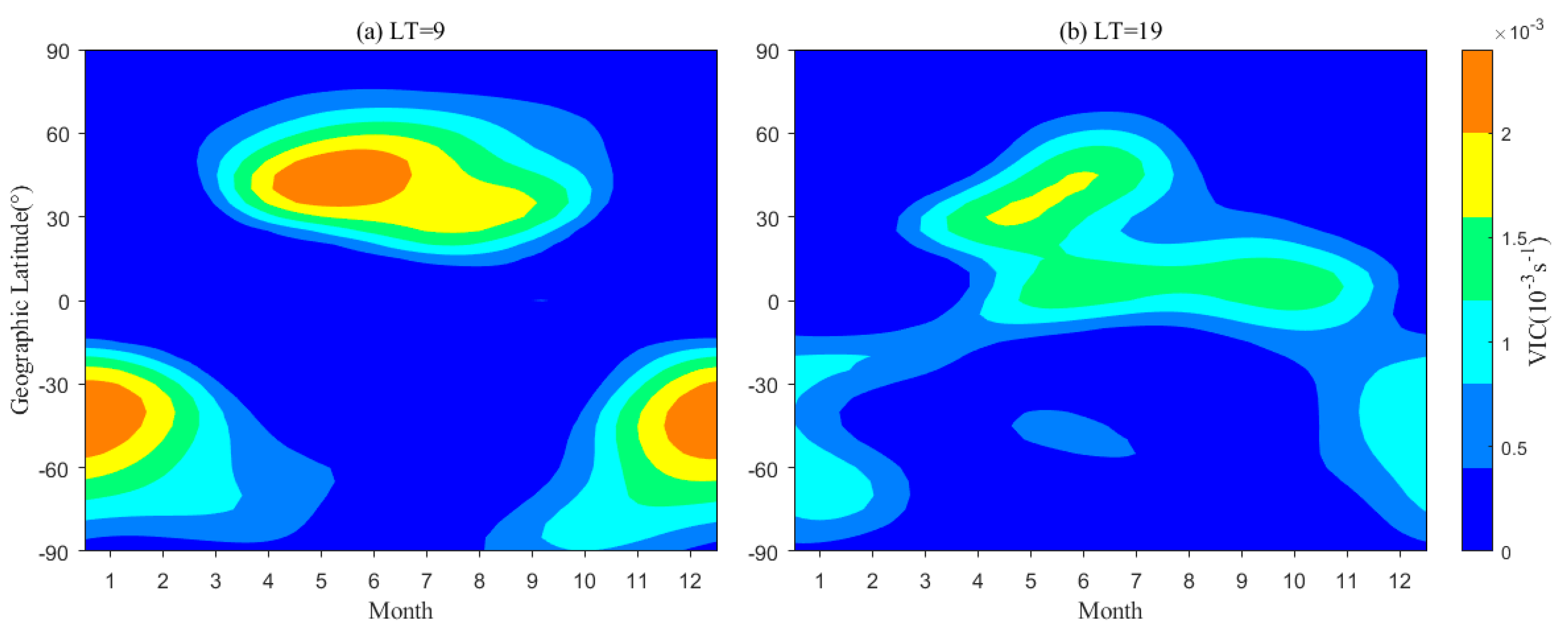
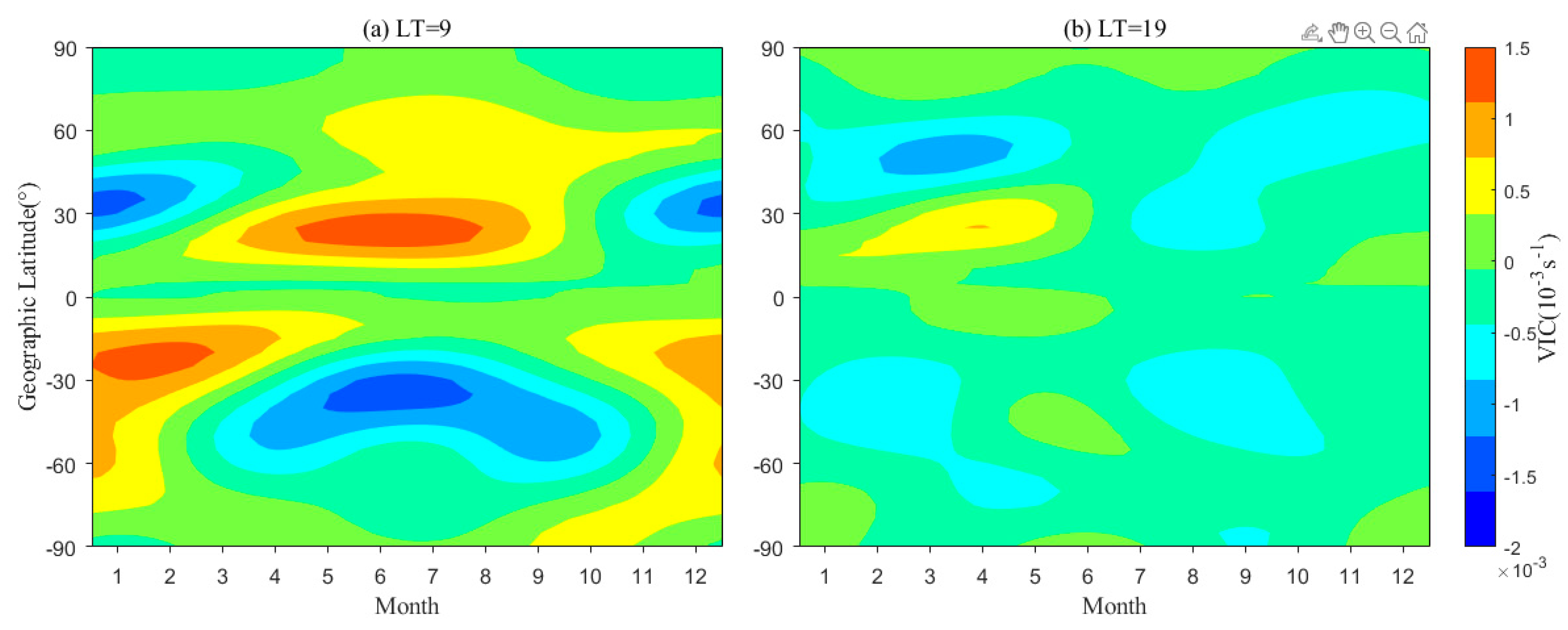

Disclaimer/Publisher’s Note: The statements, opinions and data contained in all publications are solely those of the individual author(s) and contributor(s) and not of MDPI and/or the editor(s). MDPI and/or the editor(s) disclaim responsibility for any injury to people or property resulting from any ideas, methods, instructions or products referred to in the content. |
© 2025 by the authors. Licensee MDPI, Basel, Switzerland. This article is an open access article distributed under the terms and conditions of the Creative Commons Attribution (CC BY) license (https://creativecommons.org/licenses/by/4.0/).
Share and Cite
Ruan, H.; Qiu, X.; Guo, X.; Wang, X.; Zhang, X. Climatological Investigation of Ionospheric Es Layer Based on Occultation Data. Remote Sens. 2025, 17, 280. https://doi.org/10.3390/rs17020280
Ruan H, Qiu X, Guo X, Wang X, Zhang X. Climatological Investigation of Ionospheric Es Layer Based on Occultation Data. Remote Sensing. 2025; 17(2):280. https://doi.org/10.3390/rs17020280
Chicago/Turabian StyleRuan, Haibing, Xiuwen Qiu, Xin Guo, Xiangxue Wang, and Xin Zhang. 2025. "Climatological Investigation of Ionospheric Es Layer Based on Occultation Data" Remote Sensing 17, no. 2: 280. https://doi.org/10.3390/rs17020280
APA StyleRuan, H., Qiu, X., Guo, X., Wang, X., & Zhang, X. (2025). Climatological Investigation of Ionospheric Es Layer Based on Occultation Data. Remote Sensing, 17(2), 280. https://doi.org/10.3390/rs17020280






